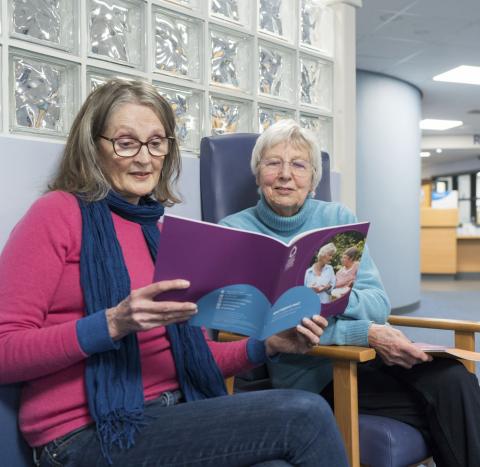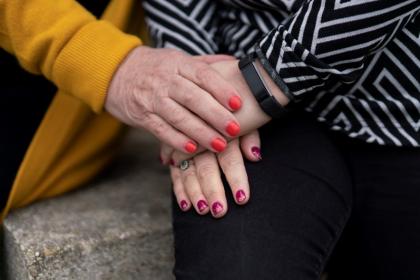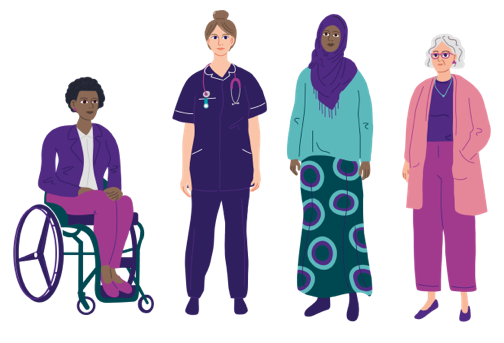Each year 7,400 women are diagnosed with ovarian cancer in the UK.
The risk of developing ovarian cancer in the general population is 2% (or 2 in 100 women). But some factors can increase your risk.
Anyone born with ovaries or fallopian tubes is at risk of developing ovarian cancer. This means most women and trans men, some non-binary people, and some people who have differences in sex development are at risk of ovarian cancer. If your ovaries and fallopian tubes have been removed you’re at lower risk, but a small risk still remains.
What are risk factors?
A risk factor is something that can increase your chances of developing a cancer. Different cancers have different risk factors. Some risks are linked with more than one cancer.
There are a number of possible causes of ovarian cancer but these aren’t yet fully understood. The most important risk factors are age and a strong family history of ovarian or breast cancer.
Age
As with most cancers the risk of developing ovarian cancer increases as you get older. Those over the age of 50 have a higher risk. Most cases of ovarian cancer happen in those who have already gone through the menopause (when you stop having periods). More than 50 in 100 cases of ovarian cancer are in those over 65 years.
Although it's not common, if you're younger and haven’t been through the menopause you can get ovarian cancer. Over 1,000 women under the age of 50 develop ovarian cancer every year. That’s why it's important that everyone is aware of the symptoms of ovarian cancer. This is especially important if you have a family history of ovarian or breast cancer.
Family history
About 80 in 100 cases of ovarian cancer are 'sporadic'. This means they're one-offs and not inherited and close relatives face no significant increase in their risk of developing the disease themselves. This is important to remember, as it can be worrying if a close family member is affected by ovarian cancer.
About 20 in 100 cases of ovarian cancer are believed to be caused by an inherited genetic variant (or mutated gene). This is often the BRCA1 or BRCA2 gene (BReast CAncer 1 and 2). If you inherit a variant of the BRCA1 or BRCA2 gene you have a much higher risk of developing breast and/or ovarian cancer than the general population.
There are some other genes which have also been linked to ovarian cancer. These include PALB2, RAD51C, RAD51D, STK11 and BRIP1 (FABCJ) and those linked to Lynch Syndrome (formerly known as hereditary non polyposis colorectal cancer or HNPCC). The chance of developing cancer of the stomach, liver, kidney, bladder, skin and brain can also be increased by having a variant in one of the Lynch Syndrome genes.
Speak to your GP if there are two or more cases of ovarian cancer and/or breast cancer on either your mother or father's side of the family. Your GP will offer you more information about your level of risk. They may then refer you to a genetic counsellor to help you decide whether to have genetic testing. If you carry a variant in a gene such as BRCA1 or BRCA2 it may increase your risk of developing ovarian or breast cancer in future.
Your genetic counsellor and specialist team will support you through this process. They will help you to understand your risk and offer advice on risk management options.
More about hereditary ovarian cancer.
Other ovarian cancer risk factors
-
Weight
-
There’s some evidence that being overweight or obese can increase the risk of ovarian cancer but this increase is small. The risk of developing ovarian cancer in the general population is 2% (2 in 100). It’s suggested that if you’re overweight this risk increases to 2.14% and if you’re obese this risk increases to 2.56%. This is just over 2 in 100.
Studies suggest that this risk may increase as a person’s body mass index (BMI) increases. Calculate your BMI.
- Using talcum powder
-
The evidence to show a link between using talcum powder between the legs and ovarian cancer is limited. Some studies show a small weak link but the evidence isn’t yet strong enough to support this. Other studies show no link. More, higher quality research needs to be done in this area.
- Use of hormone replacement therapy (HRT)
-
Some research suggests that taking hormonal replacement therapy (HRT) may slightly increase your risk of developing ovarian cancer. Different studies give different results for the exact level of risk, but it's likely that this risk is small.
HRT can be useful for those experiencing symptoms while going through the menopause. You should talk to your GP about the benefits and risks of HRT before making a decision about whether to take it.
- Endometriosis
-
There’s some evidence to suggest that if you have endometriosis there’s a small increased risk of developing ovarian cancer (twice as likely). This means that, where the risk of developing ovarian cancer in the general population is 2 in 100, the likelihood of developing ovarian cancer if you have endometriosis is 4 in 100.
Studies suggest it’s linked more with certain types of ovarian cancer such as clear cell and endometrioid epithelial cancer.
- Smoking
-
Under 1 in 100 cases of ovarian cancer in the UK are linked to smoking. Some studies suggest that there's more of a link between smoking and mucinous ovarian cancer tumours, compared to other types of ovarian cancer. But more research is needed to confirm this.
- Diabetes
-
Some research suggests there is around a 20% increased risk of developing cancer in those with diabetes compared to those without. So, where the risk of developing ovarian cancer is 2% (2 in 100) in the general population, the risk of developing ovarian cancer if you have diabetes is 2.4% (just over 2 in 100). This is a small increase in risk.
Last reviewed: April 2023
Next review: April 2025
To learn more about our review process, take a look at our information standards.





